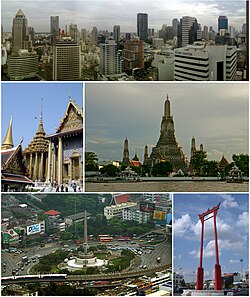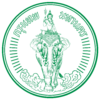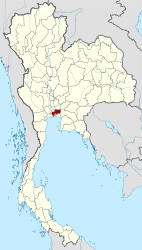Bangkok
กรุงเทพมหานคร
Krung Thep Maha Nakhon |
|---|
| Special administrative area |

Clockwise from top: Si Lom–Sathon business district, Wat Arun, Giant Swing, Victory Monument, and Wat Phra Kaeo |

Flag | 
Seal |
|

Location within Thailand |
Coordinates:  13°45′N 100°28′E / 13.750°N 100.467°E / 13.750; 100.467Coordinates: 13°45′N 100°28′E / 13.750°N 100.467°E / 13.750; 100.467Coordinates:  13°45′N 100°28′E / 13.750°N 100.467°E / 13.750; 100.467[1] 13°45′N 100°28′E / 13.750°N 100.467°E / 13.750; 100.467[1] |
| Country |  Thailand Thailand |
|---|
| Region | Central Thailand |
|---|
| Settled | c 15th century |
|---|
| Founded as capital | 21 April 1782 |
|---|
| Re-incorporated | 13 December 1972 |
|---|
| Founded by | King Rama I |
|---|
| Governing body | Bangkok Metropolitan Administration |
|---|
| Government |
|---|
| • Type | Special administrative area |
|---|
| • Governor | Sukhumbhand Paribatra (Democrat Party) |
|---|
| Area[1] |
|---|
| • City | 1,568.737 km2 (605.693 sq mi) |
|---|
| • Metro[2] | 7,761.6 km2 (2,996.8 sq mi) |
|---|
| Elevation[3] | 1.5 m (4.9 ft) |
|---|
| Population (2010 census)[4] |
|---|
| • City | 8,280,925 |
|---|
| • Density | 5,300/km2 (14,000/sq mi) |
|---|
| • Metro | 14,565,547 |
|---|
| • Metro density | 1,900/km2 (4,900/sq mi) |
|---|
| Demonym | Bangkokian |
|---|
| Time zone | Thailand (UTC+7) |
|---|
| Postal code | 10### |
|---|
| Area code(s) | 02 |
|---|
| ISO 3166 code | TH-10 |
|---|
| Website | www.bangkok.go.th |
|---|
Bangkok (
English pronunciation: //) is the capital and the most populous city of
Thailand. It is known in
Thai as
Krung Thep Maha Nakhon (
กรุงเทพมหานคร, pronounced
[krūŋ tʰêːp mahǎː nákʰɔ̄ːn] ( listen)
listen)) or simply
 Krung Thep (help·info)
Krung Thep (help·info). The city occupies 1,568.7 square kilometres (605.7 sq mi) in the
Chao Phraya River delta in Central Thailand, and has a population of over eight million, or 12.6 percent of the country's population. Over fourteen million people (22.2 percent) live within the surrounding
Bangkok Metropolitan Region, making Bangkok an extreme
primate city, dwarfing Thailand's other urban centres in terms of importance.
Bangkok traces its roots to a small trading post during the
Ayutthaya Kingdom in the 15th century, which eventually grew in size and became the site of two capital cities: Thonburi in 1768 and Rattanakosin in 1782. Bangkok was at the heart of Siam's (as Thailand used to be known) modernization during the later nineteenth century, as the country faced pressures from the West. The city was the centre stage of Thailand's political struggles throughout the twentieth century, as the country abolished absolute monarchy, adopted constitutional rule and underwent numerous coups and uprisings. The city grew rapidly during the 1960s through the 1980s and now exerts a significant impact among Thailand's politics, economy, education, media and modern society.
Images of Bangkok Thailand can be seen by opening the link below.
http://www.bing.com/images/search?q=bangkok+thailand&qpvt=bangkok+thailand&FORM=IGRE
Climate
Like most of Thailand, Bangkok has a
tropical wet and dry climate under the
Köppen climate classification and is under the influence of the
South Asian monsoon system. It experiences hot, rainy and cool seasons, although temperatures are fairly hot year-round, ranging from an average low of 20.8 °C (69.4 °F) in December to an average high of 34.9 °C (94.8 °F) in April. The rainy season begins with the arrival of the southwest monsoon around mid-May. September is the wettest month, with an average rainfall of 344.2 millimetres (13.55 in). The rainy season lasts until October, when the dry and cool northeast monsoon takes over until February. The hot season is generally dry, but also sees occasional summer storms. The surface magnitude of Bangkok's
urban heat island has been measured at 2.5 °C (4.5 °F) during the day and 8.0 °C (14 °F) at night.
The highest recorded temperature in Bangkok is 40.8 °C (105.4 °F) in May 1983, and the lowest recorded temperature is 9.9 °C (49.8 °F) in January 1955.
| Climate data for Bangkok (1961–1990) |
|---|
| Month | Jan | Feb | Mar | Apr | May | Jun | Jul | Aug | Sep | Oct | Nov | Dec | Year |
|---|
| Record high °C (°F) | 35.7
(96.3) | 36.6
(97.9) | 37.8
(100) | 40.0
(104) | 39.5
(103.1) | 37.7
(99.9) | 37.8
(100) | 37.0
(98.6) | 36.0
(96.8) | 35.3
(95.5) | 35.1
(95.2) | 35.2
(95.4) | 40.0
(104) |
|---|
| Average high °C (°F) | 32.0
(89.6) | 32.7
(90.9) | 33.7
(92.7) | 34.9
(94.8) | 34.0
(93.2) | 33.1
(91.6) | 32.7
(90.9) | 32.5
(90.5) | 32.3
(90.1) | 32.0
(89.6) | 31.6
(88.9) | 31.3
(88.3) | 32.7
(90.9) |
|---|
| Daily mean °C (°F) | 25.9
(78.6) | 27.4
(81.3) | 28.7
(83.7) | 29.7
(85.5) | 29.2
(84.6) | 28.7
(83.7) | 28.3
(82.9) | 28.1
(82.6) | 27.8
(82) | 27.6
(81.7) | 26.9
(80.4) | 25.6
(78.1) | 27.8
(82) |
|---|
| Average low °C (°F) | 21.0
(69.8) | 23.3
(73.9) | 24.9
(76.8) | 26.1
(79) | 25.6
(78.1) | 25.4
(77.7) | 25.0
(77) | 24.9
(76.8) | 24.6
(76.3) | 24.3
(75.7) | 23.1
(73.6) | 20.8
(69.4) | 24.1
(75.4) |
|---|
| Record low °C (°F) | 11.5
(52.7) | 14.9
(58.8) | 15.7
(60.3) | 19.9
(67.8) | 21.1
(70) | 21.7
(71.1) | 22.2
(72) | 21.2
(70.2) | 21.7
(71.1) | 18.3
(64.9) | 14.2
(57.6) | 10.5
(50.9) | 10.5
(50.9) |
|---|
| Rainfall mm (inches) | 9.1
(0.358) | 29.9
(1.177) | 28.6
(1.126) | 64.7
(2.547) | 220.4
(8.677) | 149.3
(5.878) | 154.5
(6.083) | 196.7
(7.744) | 344.2
(13.551) | 241.6
(9.512) | 48.1
(1.894) | 9.7
(0.382) | 1,496.8
(58.929) |
|---|
| Avg. rainy days (≥ 1 mm) | 1 | 3 | 3 | 6 | 16 | 16 | 18 | 20 | 21 | 17 | 6 | 1 | 128 |
|---|
| Mean monthly sunshine hours | 272.8 | 251.4 | 269.7 | 258.0 | 217.0 | 177.0 | 170.5 | 161.2 | 156.0 | 198.4 | 234.0 | 263.5 | 2,629.5 |
|---|
| Source #1: Thai Meteorological Department[32] |
| Source #2: Hong Kong Observatory (daily mean, sunshine),[33] NOAA (extremes)[34] |

















